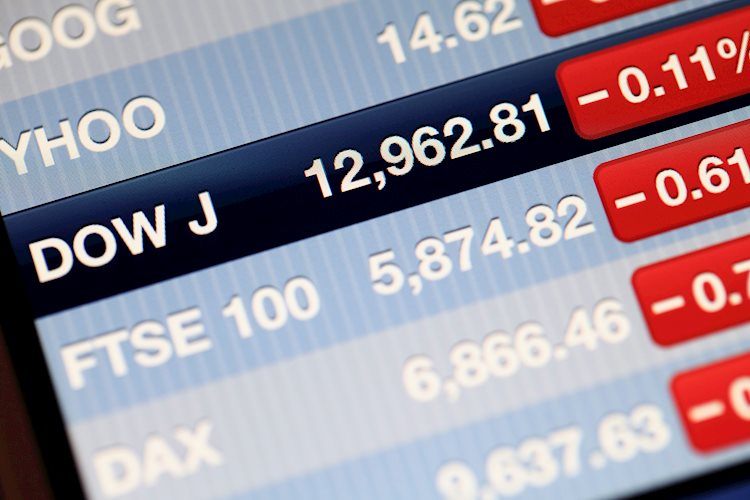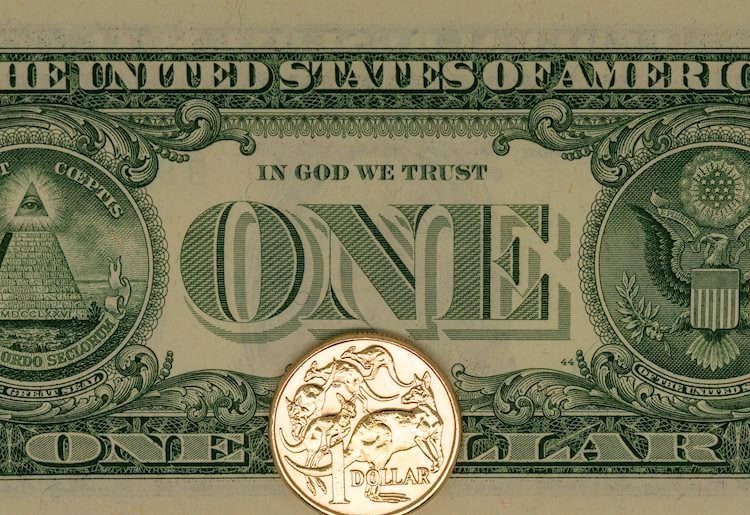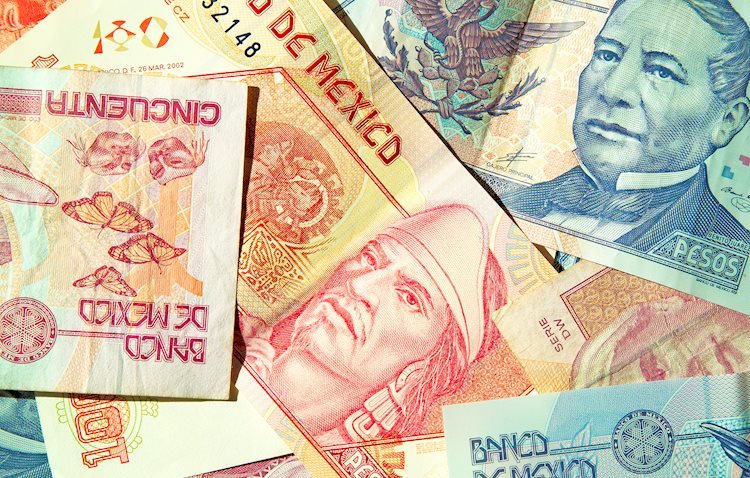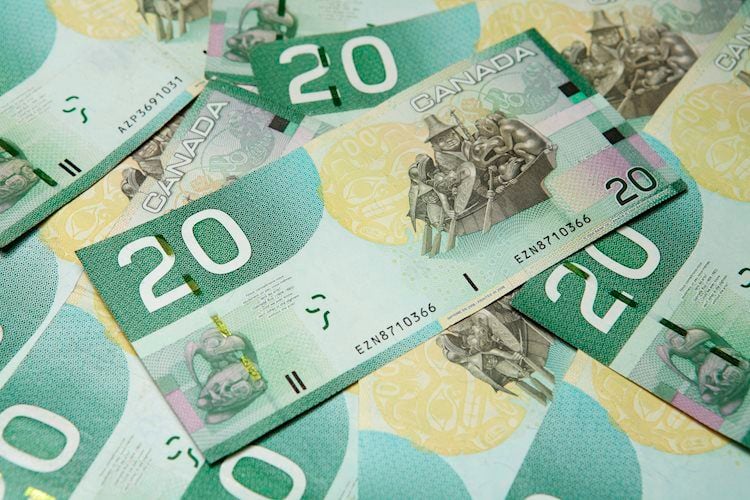Share:
Gold price gains strong positive traction on Monday and spikes to a fresh all-time peak.
The cautious market mood, along with dovish Fed expectations, benefits the XAU/USD.
Overstretched conditions on the daily chart prompt some profit-taking at higher levels.
Gold price (XAU/USD) builds on its recent strong rally witnessed over the past three weeks or so and surges to a fresh record high, around the $2,144-2,145 region during the Asian session on Monday. The precious metal, however, surrendered a major part of its intraday gains and currently trades below the $2,100 mark, still up around 0.70% for the day. Bulls opt to take some profits off the table amid extremely overbought conditions on the daily chart and a modest US Dollar (USD) uptick. The downside remains cushioned in the wake of growing acceptance that the Federal Reserve (Fed) will start cutting interest rates by as soon as March 2024, which continues to benefit the non-yielding yellow metal.
Apart from this, the geopolitical uncertainty and fears of another COVID-19-like respiratory illness outbreak in China, which is seen weighing on investors’ sentiment, might further limit any meaningful pullback for the safe-haven Gold price. An attack on an American warship and commercial vessels operating in the Red Sea fueled concerns over a further escalation in the Israel-Hamas war. Meanwhile, a surge in respiratory illnesses and clusters of pneumonia in children in China attracted the spotlight when the World Health Organization sought information last week. This contributes to cap the recent upswing in the global equity markets and could undermine the safe-haven XAU/USD.
The global risk-on rally hit a roadblock after an attack on an American warship and commercial vessels in the Red Sea on Sunday by Iran-backed Houthi rebels in Yemen.
A US military official confirmed that a “self-defence strike on an imminent threat” killed five Iraqi militants near the northern city of Kirkuk on Sunday afternoon.
The risk of a further escalation of geopolitical tensions in the Middle East, along with a surge in cases of respiratory illnesses in China, boosts the safe-haven Gold price.
This comes on the back of growing acceptance that the Federal Reserve (Fed) will maintain the status quo in December and start cutting rates as early as March 2024.
Fed Jerome Powell on Friday said that it would be premature to conclude when policy might ease, pushing back against speculations of more aggressive rate cuts.
Investors, however, seem convinced about an imminent shift in the Fed’s policy stance, which drags the benchmark 10-year US Treasury yield to a 12-week low.
Dovish Fed expectations, meanwhile, keep the US Dollar bulls on the defensive and lend additional support to the XAU/USD ahead of this week’s important US macro data.
This week’s US economic docket highlights the release of the ISM Services PMI on Tuesday, followed by the ADP report on private-sector employment on Wednesday and the US crucial NFP report on Friday.
A recent survey by the World Gold Council showed that 24% of all central banks intend to increase their Gold reserves in the next 12 months, as they increasingly grow pessimistic about the US as a reserve asset.
From a technical perspective, the intraday pullback drags the precious metal below the 23.6% Fibonacci retracement level of the rally from the November monthly swing low, around the $1,932-$1,931 region. The Relative Strength Index (RSI) on the daily chart is flashing extremely overbought conditions and holding back bulls from placing fresh bets around the Gold price.
Any further pullback, however, is likely to find support near the $2,079-2,080 area, or the previous all-time peak touched in May, below which the XAU/USD could slide to the 38.2% Fibo. level, around the $2063-2,062 zone. On the flip side, move back above the $2,095-2,100 immediate hurdle might now confront some resistance near the $2,118 area. Some follow-through buying should allow the Gold price to retest the record high around the $2,144-$2,145 region, which if cleared will reinforce the near-term positive outlook and pave the way for additional gains.
US Dollar price today
The table below shows the percentage change of US Dollar (USD) against listed major currencies today. US Dollar was the weakest against the Euro.
USD
EUR
GBP
CAD
AUD
JPY
NZD
CHF
USD
0.02%
0.25%
0.18%
0.20%
0.12%
0.16%
0.24%
EUR
-0.03%
0.25%
0.17%
0.20%
0.09%
0.17%
0.21%
GBP
-0.27%
-0.23%
-0.07%
-0.05%
-0.13%
-0.08%
-0.01%
CAD
-0.18%
-0.16%
0.08%
0.03%
-0.08%
0.00%
0.06%
AUD
-0.20%
-0.19%
0.04%
-0.03%
-0.10%
-0.03%
0.03%
JPY
-0.15%
-0.07%
0.30%
0.08%
0.12%
0.07%
0.12%
NZD
-0.17%
-0.14%
0.09%
0.02%
0.04%
-0.04%
0.07%
CHF
-0.25%
-0.21%
0.02%
-0.05%
-0.03%
-0.11%
-0.07%
The heat map shows percentage changes of major currencies against each other. The base currency is picked from the left column, while the quote currency is picked from the top row. For example, if you pick the Euro from the left column and move along the horizontal line to the Japanese Yen, the percentage change displayed in the box will represent EUR (base)/JPY (quote).
Gold FAQs
Why do people invest in Gold?
Gold has played a key role in human’s history as it has been widely used as a store of value and medium of exchange. Currently, apart from its shine and usage for jewelry, the precious metal is widely seen as a safe-haven asset, meaning that it is considered a good investment during turbulent times. Gold is also widely seen as a hedge against inflation and against depreciating currencies as it doesn’t rely on any specific issuer or government.
Who buys the most Gold?
Central banks are the biggest Gold holders. In their aim to support their currencies in turbulent times, central banks tend to diversify their reserves and buy Gold to improve the perceived strength of the economy and the currency. High Gold reserves can be a source of trust for a country’s solvency. Central banks added 1,136 tonnes of Gold worth around $70 billion to their reserves in 2022, according to data from the World Gold Council. This is the highest yearly purchase since records began. Central banks from emerging economies such as China, India and Turkey are quickly increasing their Gold reserves.
How is Gold correlated with other assets?
Gold has an inverse correlation with the US Dollar and US Treasuries, which are both major reserve and safe-haven assets. When the Dollar depreciates, Gold tends to rise, enabling investors and central banks to diversify their assets in turbulent times. Gold is also inversely correlated with risk assets. A rally in the stock market tends to weaken Gold price, while sell-offs in riskier markets tend to favor the precious metal.
What does the price of Gold depend on?
The price can move due to a wide range of factors. Geopolitical instability or fears of a deep recession can quickly make Gold price escalate due to its safe-haven status. As a yield-less asset, Gold tends to rise with lower interest rates, while higher cost of money usually weighs down on the yellow metal. Still, most moves depend on how the US Dollar (USD) behaves as the asset is priced in dollars (XAU/USD). A strong Dollar tends to keep the price of Gold controlled, whereas a weaker Dollar is likely to push Gold prices up.
Share:
Feed news
Information on these pages contains forward-looking statements that involve risks and uncertainties. Markets and instruments profiled on this page are for informational purposes only and should not in any way come across as a recommendation to buy or sell in these assets. You should do your own thorough research before making any investment decisions. FXStreet does not in any way guarantee that this information is free from mistakes, errors, or material misstatements. It also does not guarantee that this information is of a timely nature. Investing in Open Markets involves a great deal of risk, including the loss of all or a portion of your investment, as well as emotional distress. All risks, losses and costs associated with investing, including total loss of principal, are your responsibility. The views and opinions expressed in this article are those of the authors and do not necessarily reflect the official policy or position of FXStreet nor its advertisers. The author will not be held responsible for information that is found at the end of links posted on this page.
If not otherwise explicitly mentioned in the body of the article, at the time of writing, the author has no position in any stock mentioned in this article and no business relationship with any company mentioned. The author has not received compensation for writing this article, other than from FXStreet.
FXStreet and the author do not provide personalized recommendations. The author makes no representations as to the accuracy, completeness, or suitability of this information. FXStreet and the author will not be liable for any errors, omissions or any losses, injuries or damages arising from this information and its display or use. Errors and omissions excepted.
The author and FXStreet are not registered investment advisors and nothing in this article is intended to be investment advice.





